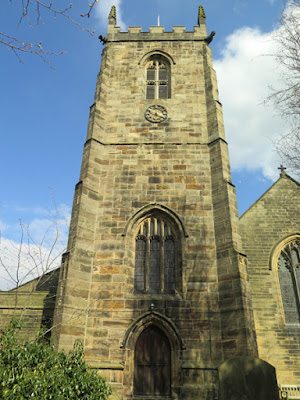 |
| The Robin Hood statue on Castle Road |
In my investigations of geological sites, mediaeval churches and historic stone buildings to date, on a very limited budget, I have mainly relied on public transport with a limited use travel pass and my trips with the Sheffield U3A Geology Group – with the vast majority of the places that I have visited being freely accessible.
 |
| A map of Nottingham |
Occasionally, however, I have treated myself to a day out to places much further afield or those that I thought were really worth visiting – such as the Tower of London, Rochester Castle, Selby Abbey and Haddon Hall – and included in this category is a very long day out to Nottingham over the 2019 Easter Bank Holiday.
 |
| A view along High Pavement in the Lace Market |
After taking a year out after school, to work for a small general building contractor, I studied geology, with subsidiary chemistry and zoology, at the University of Nottingham but we were never shown any of the local geology – nor did I explore the city beyond its pubs!
 |
| St. Mary's church |
Graduating with an average 2:II degree, apart from topping the class in Industrial and Environmental Geology, my geological map of the Borrowdale Volcanics being highly commended by Janet Watson - and my interest in microscopy, which led to my unique Glowing Edges Designs – I can’t say that I studied as hard as I should have, but those topics that interested me certainly influenced my subsequent career.
 |
| St. Peter's church |
As a Cadet Valuer with the District Valuer/Valuation Office, a contract manager in the building restoration industry, a co-owner of Triton Building Restoration Ltd, a “stone matching” expert and a specialist in Geoconservation/Geoheritage – as well as my photography - my passion for rocks in its many forms is an underlying theme.
 |
| A distant view of Wollaton Hall |
I only knew the Bunter Sandstone seen around Nottingham Castle and The Park and the ubiquitous Linby stone used for boundary walls and so I made a great effort to see as much as I could in one day.
 |
| A display of fossils in Wollaton Hall |
Continuing with my investigation of mediaeval churches, after buying a new pair of walking boots, I went to have a good look at the Lace Market and St. Mary’s church where I encountered a wide variety of building stones – some of which I hadn’t seen before. I then explored St. Peter’s church, before catching the bus to Wollaton Hall and Park, where I was interested in both the architecture and the museum’s geology collection.
Returning to Nottingham on the bus, I got off at Canning Circus to have a quick look at the general cemetery before exploring The Ropewalk and parts of The Park, where I encountered various exposures of the Triassic Nottingham Castle Sandstone Formation and the famous Robin Hood statue, before ending my day with a few beers at Ye Olde Trip to Jerusalem.
 |
| Ye Olde Trip to Jerusalem |














































